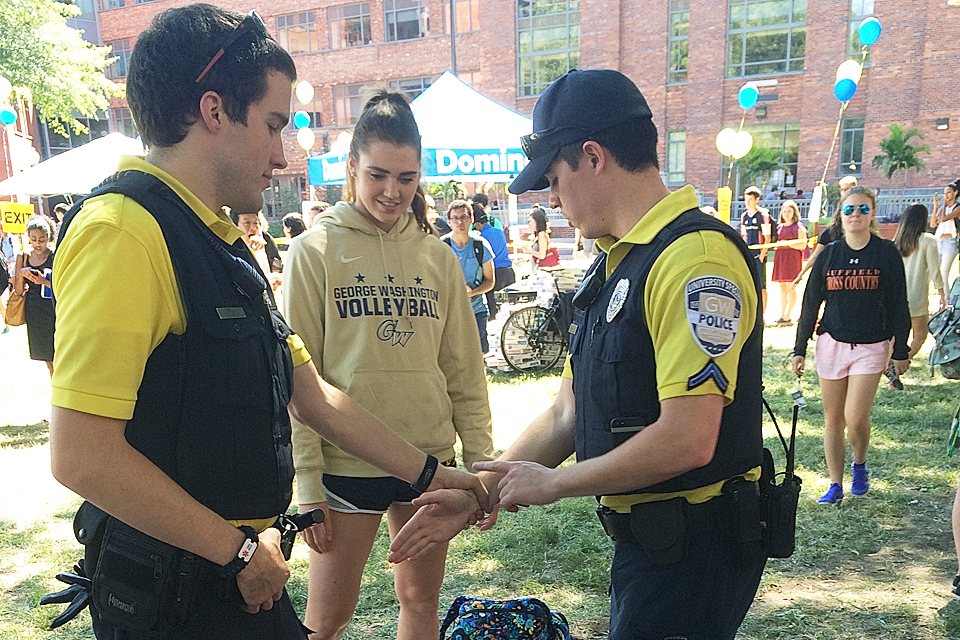By Ruth Steinhardt
“Lower your chin,” instructed George Washington Police Officer John Phelan, illustrating for the assembled group of students and staff as, behind him, another officer posed as an assailant. “Smile—that tenses up the muscles of your neck and jaw. Then drop your center of gravity, raise your hand like you’re asking a question and turn.”
Mr. Phelan was demonstrating how to break a chokehold as part of the George Washington University’s 11th annual Safety Expo, a tradition organized by the university’s Office of Safety and Security as part of National Preparedness Month. Attendees on Wednesday afternoon on the Foggy Bottom Campus could build their own disaster preparedness kits, use a fire extinguisher, practice basic CPR or—as Mr. Phelan’s audience was doing—learn self-defense.
“The expo is an important tradition and a good way to kick off the academic year,” said Darrell Darnell, senior associate vice president for safety and security. “Incoming students can get reintroduced to safety concepts, meet with safety professionals and reintroduce the need to engage with safety on a daily basis.”
The Virginia Science and Technology Campus will hold its own Safety Expo from 11 a.m. to 1 p.m. Sept. 30 at Innovation Hall Room 121.
The expo is traditionally hands-on, giving participants firsthand experience with basic safety tools. On one side of University Yard, a giggling group of students wearing goggles to simulate blood alcohol level floundered through field sobriety tests like standing on one leg and walking in a straight line. Nearby, a fire extinguisher whooshed as students practiced putting out a small demonstration flame.

George Washington Police Officer John Phelan demonstrates how to get out of an attacker's hold to GW student Alexis Lete during the 11th annual Safety Expo. Mr. Phelan is assisted by GW Police Officer Nate Hoffer. (Rob Stewart/GW Today)
This year’s expo had 28 partner agencies and organizations from traditional first responder agencies such as the Metropolitan Police Department and the DC Fire and Emergency Medical Services Department to DC Water and Sewer Authority, the National Capital Poison Center and the National Weather Service, among others. Also participating were nonprofit organizations including Men Can Stop Rape, the DC Coalition Against Domestic Violence, the DC Rape Crisis Center and the Network for Victim Recovery of DC.
“The GW Expo is the largest collegiate preparedness event in the D.C. metro area,” said George Nunez, director of the GW Office of Emergency Management. “It brings together the university community with local, federal and community partners to increase emergency preparedness and personal safety. We take a comprehensive approach to safety, and the expo is reflective of that.”
As in previous years, several agencies including the D.C. Homeland Security and Emergency Management Agency and the U.S. Postal Inspection Service provided tours of their mobile command vehicles, giving participants an inside look at emergency management.
“Emergency preparation is a huge part of public health, especially with all of the disasters that have happened recently—Ebola, flooding, hurricanes,” said Ariel Sherman, a graduate student in the Milken Institute School of Public Health, as she waited in line for a chance to win a water bottle from DC Water and the TapIt program. “It’s really important to have a solid plan, so this [expo] is a cool way of doing that.”
The subject of safety was on the minds of GW participants, with the expo coming just a week after a rooftop fire necessitated evacuation of Fulbright Hall.
“What we saw with the fire in Fulbright was a good example of people knowing what to do and not taking safety for granted,” Mr. Darnell pointed out. “Students followed procedures, the responding officers did what they were supposed to, and as a result we had a successful evacuation and nobody got hurt. That’s what we want, for people to be aware of their surroundings and follow safety guidelines and—maybe this sounds trite—but just be safe.”


